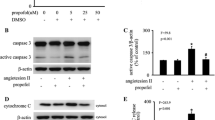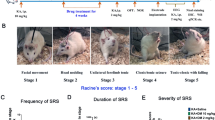Abstract
Electroconvulsive therapy (ECT) performed under general anesthesia is an effective treatment for severe depression. Etomidate is an intravenous anesthetic that shows beneficial effects on ECT. However, the potential mechanisms have rarely been reported. In this study, male rats were exposed to chronic unpredictable mild stress for 4 weeks, followed by ECT for 10 days, with or without intervention with ferrostatin-1 (2 mg/kg) or all-trans retinoic acid (ATRA, 5 mg/kg). Rats subjected to etomidate (20 mg/kg) or propofol (120 mg/kg) treatment were administered with designated anesthetic before ECT. Compared to depressive rats without ECT, those who received ECT showed increased numbers of hippocampal neurons, increased expression of negative regulators of ferroptosis including glutathione peroxidase 4, ferritin heavy chain 1, and ferroptosis suppressor protein 1, upregulation of brain-derived neurotrophic factor and nuclear factor erythroid 2-related factor, and downregulation of acyl-CoA synthetase long-chain family member 4, a positive regulator of ferroptosis in the hippocampus. Additionally, compared with propofol, etomidate used in ECT resulted in higher upregulation of BDNF/Nrf2 and inhibited neuronal ferroptosis in hippocampus. These results showed etomidate may enhance the antidepressant effect of ECT by protecting hippocampal neurons against ferroptosis.








Similar content being viewed by others
Data Availability
The datasets generated during and/or analyzed during the current study are available from the corresponding author on reasonable request.
References
Malhi GS, Mann JJ (2018) Depression. Lancet 392(10161):2299–2312
Organization WH (2017) Depression and other common mental disorders: global health estimates. Available from: https://www.who.int/publications/i/item/depression-global-health-estimates
Charlson FJ, Baxter AJ, Cheng HG, Shidhaye R, Whiteford HA (2016) The burden of mental, neurological, and substance use disorders in China and India: a systematic analysis of community representative epidemiological studies. Lancet 388(10042):376–389
Sackeim HA (2017) Modern electroconvulsive therapy: vastly improved yet greatly underused. JAMA Psychiat 74(8):779–780
Kaster TS, Blumberger DM, Gomes T, Sutradhar R, Wijeysundera DN, Vigod SN (2022) Risk of suicide death following electroconvulsive therapy treatment for depression: a propensity score-weighted, retrospective cohort study in Canada. Lancet Psychiatry 9(6):435–446
Chevalier G, Siopi E, Guenin-Macé L, Pascal M, Laval T, Rifflet A, Boneca IG, Demangel C et al (2020) Effect of gut microbiota on depressive-like behaviors in mice is mediated by the endocannabinoid system. Nat Commun 11(1):6363
Soga T, Nakajima S, Kawaguchi M, Parhar IS (2021) Repressor element 1 silencing transcription factor/neuron-restrictive silencing factor (REST/NRSF) in social stress and depression. Prog Neuropsychopharmacol Biol Psychiatry 104:110053
Stockwell BR, Friedmann Angeli JP, Bayir H, Bush AI, Conrad M, Dixon SJ, Fulda S, Gascón S et al (2017) Ferroptosis: a regulated cell death nexus linking metabolism, redox biology, and disease. Cell 171(2):273–285
Cao H, Zuo C, Huang Y, Zhu L, Zhao J, Yang Y, Jiang Y, Wang F (2021) Hippocampal proteomic analysis reveals activation of necroptosis and ferroptosis in a mouse model of chronic unpredictable mild stress-induced depression. Behav Brain Res 407:113261
Zhang H, Jiao W, Cui H, Sun Q, Fan H (2021) Combined exposure of alumina nanoparticles and chronic stress exacerbates hippocampal neuronal ferroptosis via activating IFN-γ/ASK1/JNK signaling pathway in rats. J Hazard Mater 411:125179
Wang Y, Wang S, Xin Y, Zhang J, Wang S, Yang Z, Liu C (2021) Hydrogen sulfide alleviates the anxiety-like and depressive-like behaviors of type 1 diabetic mice via inhibiting inflammation and ferroptosis. Life Sci 278:119551
Jiao H, Yang H, Yan Z, Chen J, Xu M, Jiang Y, Liu Y, Xue Z et al (2021) Traditional Chinese formula xiaoyaosan alleviates depressive-like behavior in CUMS mice by regulating PEBP1-GPX4-mediated ferroptosis in the hippocampus. Neuropsychiatr Dis Treat 17:1001–1019
Abdalkader M, Lampinen R, Kanninen KM, Malm TM, Liddell JR (2018) Targeting Nrf2 to suppress ferroptosis and mitochondrial dysfunction in neurodegeneration. Front Neurosci 12:466
Morris G, Walker AJ, Walder K, Berk M, Marx W, Carvalho AF, Maes M, Puri BK (2021) Increasing Nrf2 activity as a treatment approach in neuropsychiatry. Mol Neurobiol 58(5):2158–2182
Singh A, Kar SK (2017) How electroconvulsive therapy works?: understanding the neurobiological mechanisms. Clin Psychopharmacol Neurosci 15(3):210–221
Ishii T, Warabi E, Mann GE (2019) Circadian control of BDNF-mediated Nrf2 activation in astrocytes protects dopaminergic neurons from ferroptosis. Free Radic Biol Med 133:169–178
Bouvier E, Brouillard F, Molet J, Claverie D, Cabungcal JH, Cresto N, Doligez N, Rivat C et al (2017) Nrf2-dependent persistent oxidative stress results in stress-induced vulnerability to depression. Mol Psychiatry 22(12):1701–1713
Jia L, Hao H, Wang C, Wei J (2021) Etomidate attenuates hyperoxia-induced acute lung injury in mice by modulating the Nrf2/HO-1 signaling pathway. Exp Ther Med 22(1):785
Lv Z, Wang F, Zhang X, Zhang X, Zhang J, Liu R (2021) Etomidate attenuates the ferroptosis in myocardial ischemia/reperfusion rat model via Nrf2/HO-1 pathway. Shock 56(3):440–449
Wagner KJ, Möllenberg O, Rentrop M, Werner C, Kochs EF (2005) Guide to anaesthetic selection for electroconvulsive therapy. CNS Drugs 19(9):745–758
Gurel SC, Ozden HC, Karahan S, Ayhan Y (2022) The superiority of ketofol and etomidate against propofol or thiopental anesthesia for ECT. Asian J Psychiatr 72:103090
Valk BI, Struys M (2021) Etomidate and its analogs: a review of pharmacokinetics and pharmacodynamics. Clin Pharmacokinet 60(10):1253–1269
Zhu Z, Zhang Y, Huang X, Can L, Zhao X, Wang Y, Xue J, Cheng M et al (2021) Thymosin beta 4 alleviates non-alcoholic fatty liver by inhibiting ferroptosis via up-regulation of GPX4. Eur J Pharmacol 908:174351
Naeem K, Tariq Al Kury L, Nasar F, Alattar A, Alshaman R, Shah FA, Khan AU, Li S (2021) Natural dietary supplement, carvacrol, alleviates LPS-induced oxidative stress, neurodegeneration, and depressive-like behaviors via the Nrf2/HO-1 pathway. J Inflamm Res 14:1313–29
Ge M, Yao W, Wang Y, Yuan D, Chi X, Luo G, Hei Z (2015) Propofol alleviates liver oxidative stress via activating Nrf2 pathway. J Surg Res 196(2):373–381
Li H, Xiang Y, Zhu Z, Wang W, Jiang Z, Zhao M, Cheng S, Pan F et al (2021) Rifaximin-mediated gut microbiota regulation modulates the function of microglia and protects against CUMS-induced depression-like behaviors in adolescent rat. J Neuroinflammation 18(1):254
Huang H-J, Chen X-R, Han Q-Q, Wang J, Pilot A, Yu R, Liu Q, Li B et al (2019) The protective effects of ghrelin/GHSR on hippocampal neurogenesis in CUMS mice. Neuropharmacology 155:31–43
Chen F, Danladi J, Wegener G, Madsen TM, Nyengaard JR (2020) Sustained ultrastructural changes in rat hippocampal formation after repeated electroconvulsive seizures. Int J Neuropsychopharmacol 23(7):446–458
Gore FM, Bloem PJN, Patton GC, Ferguson J, Joseph V, Coffey C, Sawyer SM, Mathers CD (2011) Global burden of disease in young people aged 10–24 years: a systematic analysis. Lancet 377(9783):2093–2102
Ren J, Li H, Palaniyappan L, Liu H, Wang J, Li C, Rossini PM (2014) Repetitive transcranial magnetic stimulation versus electroconvulsive therapy for major depression: a systematic review and meta-analysis. Prog Neuropsychopharmacol Biol Psychiatry 51:181–189
Rajkowska G (2000) Postmortem studies in mood disorders indicate altered numbers of neurons and glial cells. Biol Psychiat 48(8):766–777
Rajkowska G, Miguel-Hidalgo JJ, Wei J, Dilley G, Pittman SD, Meltzer HY, Overholser JC, Roth BL et al (1999) Morphometric evidence for neuronal and glial prefrontal cell pathology in major depression∗∗See accompanying Editorial, in this issue. Biol Psychiat 45(9):1085–1098
Manji HK, Drevets WC, Charney DS (2001) The cellular neurobiology of depression. Nat Med 7(5):541–547
Murrough JW, Abdallah CG, Mathew SJ (2017) Targeting glutamate signalling in depression: progress and prospects. Nat Rev Drug Discov 16(7):472–486
Yang WS, Stockwell BR (2016) Ferroptosis: death by lipid peroxidation. Trends Cell Biol 26(3):165–176
Codazzi F, Pelizzoni I, Zacchetti D, Grohovaz F (2015) Iron entry in neurons and astrocytes: a link with synaptic activity. Front Mol Neurosci 8:18
Rea SL, Walsh JP, Layfield R, Ratajczak T, Xu J (2013) New insights into the role of sequestosome 1/p62 mutant proteins in the pathogenesis of Paget’s disease of bone. Endocr Rev 34(4):501–524
Khoury R, Saad J, Jabre V, Ghayad LM, Khalifeh M, Houbeika R, El Ahmad P, Mezher A et al (2023) Autophagy regulates the release of exercise factors and their beneficial effects on spatial memory recall. Heliyon 9(4):e14705
Ishii T, Warabi E, Mann GE (2019) Circadian control of BDNF-mediated Nrf2 activation in astrocytes protects dopaminergic neurons from ferroptosis. Free Radical Biol Med 133:169–178
Björkholm C, Monteggia LM (2016) BDNF – a key transducer of antidepressant effects. Neuropharmacology 102:72–79
Su YW, Zhou XF, Foster BK, Grills BL, Xu J, Xian CJ (2018) Roles of neurotrophins in skeletal tissue formation and healing. J Cell Physiol 233(3):2133–2145
Kraft AD, Johnson DA, Johnson JA (2004) Nuclear factor E2-related factor 2-dependent antioxidant response element activation by tert-butylhydroquinone and sulforaphane occurring preferentially in astrocytes conditions neurons against oxidative insult. J Neurosci 24(5):1101–1112
Ishii T, Warabi E, Mann GE (2018) Circadian control of p75 neurotrophin receptor leads to alternate activation of Nrf2 and c-Rel to reset energy metabolism in astrocytes via brain-derived neurotrophic factor. Free Radic Biol Med 119:34–44
Saffer S, Berk M (1998) Anesthetic induction for ECT with etomidate is associated with longer seizure duration than thiopentone. J ect 14(2):89–93
Acknowledgements
The authors thank all of the patients who kindly participated in this study.
Funding
This study was supported partly by the National Natural Science Foundation of China (Grant No. 82102297), Natural Science Foundation of Guangdong Province (Grant No. 2018A0303130224, 2022A1515012603), and Young Talent Support Project of Guangzhou Association for Science and Technology (Grant No. QT20220101257).
Author information
Authors and Affiliations
Contributions
All authors contributed to the study conception and design. Material preparation, data collection, and analysis were performed by Xiaoyue Li, Jingping Hu, and Xiangyang Zang. The first draft of the manuscript was written by Xiaoyue Li, and all authors commented on previous versions of the manuscript. All authors read and approved the final manuscript.
Corresponding authors
Ethics declarations
Ethics Approval
This study was approved by the Institutional Animal Care and Use Committee of Ruige Biotechnology (China).
Consent to Participate
Not applicable
Consent for Publication
Not applicable
Competing Interests
The authors declare no competing interests.
Additional information
Publisher's Note
Springer Nature remains neutral with regard to jurisdictional claims in published maps and institutional affiliations.
Supplementary Information
Below is the link to the electronic supplementary material.
Rights and permissions
Springer Nature or its licensor (e.g. a society or other partner) holds exclusive rights to this article under a publishing agreement with the author(s) or other rightsholder(s); author self-archiving of the accepted manuscript version of this article is solely governed by the terms of such publishing agreement and applicable law.
About this article
Cite this article
Li, X., Hu, J., Zang, X. et al. Etomidate Improves the Antidepressant Effect of Electroconvulsive Therapy by Suppressing Hippocampal Neuronal Ferroptosis via Upregulating BDNF/Nrf2. Mol Neurobiol 60, 6584–6597 (2023). https://doi.org/10.1007/s12035-023-03499-1
Received:
Accepted:
Published:
Issue Date:
DOI: https://doi.org/10.1007/s12035-023-03499-1




